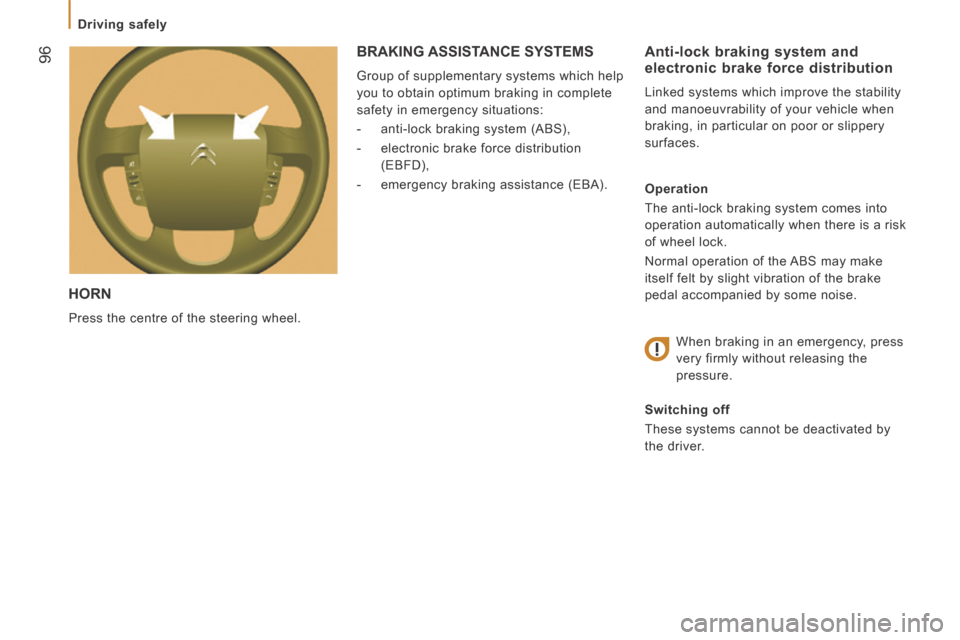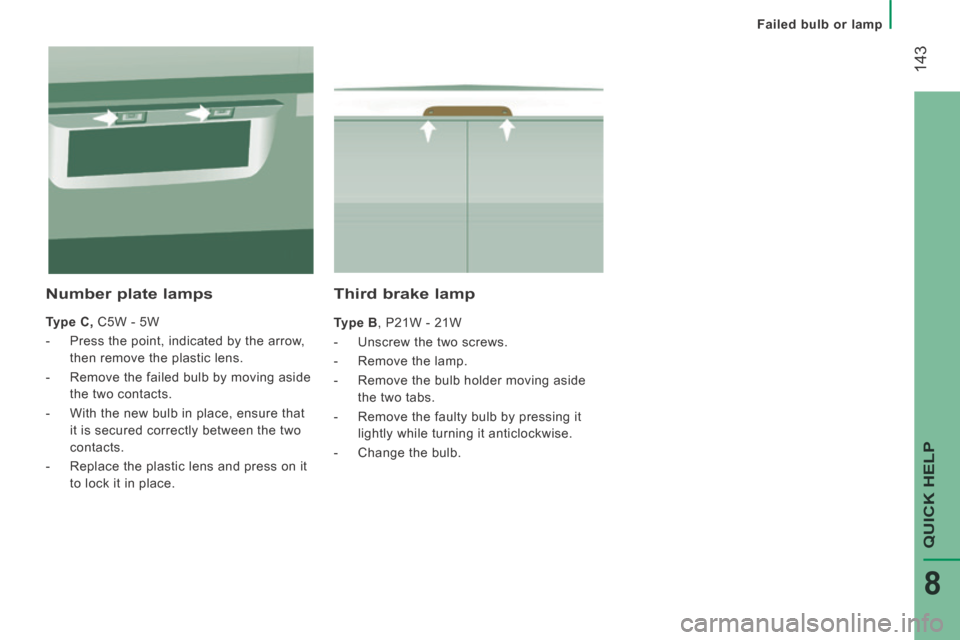2014 Citroen JUMPER brake light
[x] Cancel search: brake lightPage 12 of 240

10
Location
JUMPER-PAPIER_EN_CHAP01_COUP D OEIL_ED01-2014
Screenwash/headlamp wash, level 125
Bulbs, lighting, changing
bulbs 138-143
Opening the bonnet, stay 122
Under the bonnet 123
Engines 159
Identifi cation markings, serial
number, paint, tyres 163 Changing a wiper blade
144
Levels 124-125
● dipstick,
● power steering fl uid,
● brake fl uid,
● coolant.
Water bleed, Diesel fi lter 126
Particle fi lter 128
Emission control 33
Checks 126-128
● battery,
● air/passenger compartment fi lter,
● oil fi lter,
● manual gearbox,
● parking brake,
● brake discs and pads.
Engine fuses 134, 137
TECHNICAL DATA - MAINTENANCE
Dimensions 152-158
Weights 160-162
Page 14 of 240

12
JUMPER-PAPIER_EN_CHAP01_COUP D OEIL_ED01-2014
ECO-DRIVING
Optimise the use of your gearbox
With a manual gearbox, move off gently and change up without
waiting. While accelerating changing up early. If your vehicle has
the system, the gear shift indicator invites you to engage the most
suitable gear; follow its instructions as soon as it is displayed in
the instrument panel.
Drive smoothly
Maintain a safe distance between vehicles, use engine
braking rather than the brake pedal, and press the accelerator
progressively. These practices contribute towards a reduction in
fuel consumption and CO
2 emissions and also helps reduce the
background traffic noise.
If your vehicle has cruise control, make use of the system at
speeds above 25 mph (40 km/h) when the traffic is flowing well.
Control the use of your electrical equipment
Before moving off, if the passenger compartment is too warm,
ventilate it by opening the windows and air vents before using the
air conditioning.
Above 30 mph (50 km/h), close the windows and leave the air
vents open.
Remember to make use of equipment that can help keep the
temperature in the passenger compartment down (window
blinds...).
Switch off the air conditioning, unless it has automatic digital
regulation, as soon as the desired temperature is attained.
Switch off the demisting and defrosting controls, if not automatic.
Switch off the heated seat as soon as possible.
Switch off the headlamps and front foglamps when the level of
light does not require their use.
Eco-driving is a range of everyday practices that allow the motorist to \
optimise their fuel consumption and CO
2 emissions.
Avoid running the engine before moving off, particularly in winter;
your vehicle will warm up much faster while driving.
As a passenger, if you avoid connecting your multimedia devices
(film, music, video game...), you will contribute towards limiting the\
consumption of electrical energy, and so of fuel.
Disconnect your portable devices before leaving the vehicle.
Page 98 of 240

96
Driving safely
JUMPER-PAPIER_EN_CHAP05_SECURITE_ED01-2014
HORN
Press the centre of the steering wheel.
Anti-lock braking system and electronic brake force distribution
Linked systems which improve the stability
and manoeuvrability of your vehicle when
braking, in particular on poor or slippery
surfaces.
Operation
The anti-lock braking system comes into
operation automatically when there is a risk
of wheel lock.
Normal operation of the ABS may make
itself felt by slight vibration of the brake
pedal accompanied by some noise.
When braking in an emergency, press
very firmly without releasing the
pressure.
Switching off
These systems cannot be deactivated by
the driver.
BRAKING ASSISTANCE SYSTEMS
Group of supplementary systems which help
you to obtain optimum braking in complete
safety in emergency situations:
- anti-lock braking system (ABS),
- electronic brake force distribution (EBFD),
- emergency braking assistance (EBA).
Page 129 of 240

Levels and checks
127
7
CHECKS
JUMPER-PAPIER_EN_CHAP07_VERIFICATIONS_ED01-2014
Manual gearbox
Have the level checked in accordance with
the manufacturer's servicing schedule.
Good practice
To check the main levels and certain
components, in accordance with the
manufacturer's servicing schedule, refer to
the pages of the maintenance and warranty
guide which correspond to your vehicle's
engine.
Only use products recommended by
CITROËN or products of equivalent quality
and specification.
In order to optimise the operation of units as
important as the braking system, CITROËN
selects and offers specific products.
Oil filter
Change the filter regularly, in accordance
with the manufacturer's servicing schedule.
Brake pads
Brake pad wear depends on the style of
driving, in particular for vehicles which are
used in town, over short distances. It may
be necessary to check the thickness of the
pads, even between services.
Brake disc/drum wear status
For any information relating to checking
the brake disc/drum wear status, contact a
CITROËN dealer or a qualified workshop.
Parking brake
Where the parking brake travel is too great
or there is a reduction in the performance
of the system, the parking brake should be
adjusted, even between services.
Have the system checked by a CITROËN
dealer or a qualified workshop.
If this warning lamp comes on,
have the brake pad wear checked
by a CITROËN dealer or a
qualified workshop. In order to avoid damaging the
electrical units, high pressure washing
to clean the engine compartment is strictly
prohibited.
After washing the vehicle dampness, or in
winter, ice may form on the brake discs and
pads: braking efficiency may be reduced.
Make some light brake applications to dry
and de-ice the brakes.
Page 137 of 240

Failed fuse
135
QUICK HELP
8
JUMPER-PAPIER_EN_CHAP08_AIDE RAPIDE_ED01-2014
Fuses A (amps) Allocation
12 7.5 Right-hand dipped headlamp
13 7.5 Left-hand dipped headlamp
31 7.5 Relay supply
32 10 Cabin lighting
33 15 Rear 12 V socket
34 - Not used
35 7.5 Reversing lamp - Water in Diesel fuel sensor
36 15 Central locking control - Battery
37 7.5 Brake lamp - Third brake lamp - Instrument panel
38 10 Relay supply
39 10 Radio - Diagnostic socket - Alarm siren - Programmable additional heating - Air conditioning controls -
Tachograph - Battery
40 15 Demisting: rear screen (left), driver's side door mirror
41 15 Demisting: rear screen (right), passenger's side door mirror
42 7.5 ABS control unit and sensor - ASR sensor - DSC sensor - Brake lamp switch
43 30 Windscreen wiper motor
44 20 Cigarette lighter - Front 12 V socket
45 7.5 Door controls
46 - Not used
47 20 Driver's electric window motor
48 20 Passenger's electric window motor
49 7.5 Audio equipment - Instrument panel controls - Driver's side electric win\
dow
50 7.5 Airbags and pre-tensioners unit
51 7.5 Tachograph - Cruise control - Air conditioning controls
52 7.5 Optional relay supply
53 7.5 Instrument panel - Rear foglamp
Page 145 of 240

Failed bulb or lamp
143
QUICK HELP
8
JUMPER-PAPIER_EN_CHAP08_AIDE RAPIDE_ED01-2014
Third brake lamp
Type B , P21W - 21W
- Unscrew the two screws.
- Remove the lamp.
- Remove the bulb holder moving aside the two tabs.
- Remove the faulty bulb by pressing it lightly while turning it anticlockwise.
- Change the bulb.
Number plate lamps
Type C, C5W - 5W
- Press the point, indicated by the arrow, then remove the plastic lens.
- Remove the failed bulb by moving aside the two contacts.
- With the new bulb in place, ensure that it is secured correctly between the two
contacts.
- Replace the plastic lens and press on it to lock it in place.